1. Zen-Nihon Toyamaryu Iaido Renmei
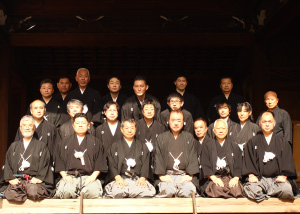
Zen Nihon Toyamaryu Iaido Renmei engages itself in activities to widely promote Japanese martial arts and culture through learning and training of Toyamaryu Iaido, not only in Japan but also abroad, and along with it activities including organizing international exchanges with overseas students of Japanese martial arts from countries such as the US, China, Hong Kong, and Spain.
Toyamaryu Iaido is based on the Gunto Soho, a consolidated, improved, and officially adopted katana swordsmanship of the Toyama Military Academy of the Imperial Japanese Army. After the Second World War, it was referred to as ‘Toyamaryu’ and established as a school of traditional Japanese swordsmanship of Iaido, and it continues to pursue the height of the art and be modified today.
Since the process of consolidation, improvement, and establishment of the Gunto Soho took approximately twenty years, from the Taisho period till the end of the Second World War, and several sword masters from different schools were involved in its development by stages, Toyamaryu is not attributed to a single founder.
The Treaty of Peace with Japan (San Francisco Peace Treaty) was signed in 1951 and came into force in 1952. As Japan regained its independence and the martial arts ban was lifted, Morinaga Kiyoshi, the former director of sword fighting at the Toyama Military Academy, Yamaguchi Yuki, Nakamura Taizaburo, and others started to call the swordsmanship based on Gunto Soho ‘Toyamaryu’, disseminating it all over Japan.
The present Zen-Nihon Toyamaryu Iaido Renmei (ZNTIR) was started as ‘Toyamaryu Shinko-kai’, established by Tokutomi Tasaburo and Nakamura Taizaburo who used to teach Gunto Soho in the army. Over the course of time ‘Toyamaryu Shinko-kai’ was renamed to the ‘Zen-Nihon Toyamaryu Iaido Renmei’.
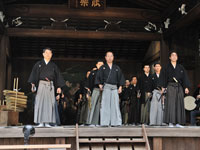
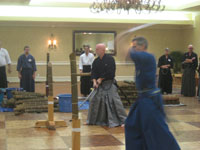
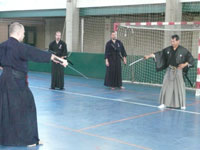
Photo : Oct. 2009 Yasukuni Shrine / Jun. 2011 US Orlando Taikai / Jul. 2011 Spain
2. Toyama Military Academy
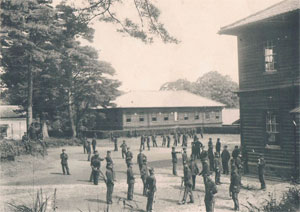
Photo : Toyama Military Academy
The beginning of the Toyama Military Academy is said to be the establishment of the Toyama Branch of Army Cadet School in June 1873, which was built at the site of one of the former town residences of the daimyo of Owari-han, in present day Toyama, Shinjuku-ku, Tokyo. In February the following year, it was renamed to Toyama Gakko (Toyama Academy) of officer training for Imperial Japanese Army.
In a booklet with the history of the Toyama Military Academy published in late December 1907, Ota Tasuku, an Imperial Army Infantry Staff Sergeant, wrote the following (excerption);
- Establishment of the School: the School was established in August 1873 and started enrolling students and administering school affairs from the 20th of the same month.
- Due to the abolition of cadet schools in May 1875, the school became an academy directly under the Ministry of War.
- Due to the regulatory changes that came into effect on 2 January 1897, the Academy, which had been overseen by the Kangun-bu department, came under the Sokan-bu department in the military and continues to be so today.
- From 1873 to 1884, specialist French officers were employed as teachers for physical training, shooting, and sword fighting.
- Intention of establishing the academy: It was an urgent requirement when establishing the Imperial Japanese Army to pursue learning in order to unify the education of the whole armed force. It is especially important to learn about the situation of the fast moving military affairs of foreign countries in order to progress in tandem with them. In order to do so, it is essential to train the officers based on the same curriculum so that a trained officer could return to his regiment with the knowledge to disseminate in order to assure even progress. That is the intention of establishing the academy.
- Later in 1903, an Imperial decree was issued defining the Toyama Military Academy to be that of providing military education and mainly infantry training in battle strategy, shooting, physical exercise, sword fighting, and drum and bugle in order to advance the whole army, to promote continuous research, to study and test portable firearms, and in the case of music students to be the future members of the military band.
- The present academy has the following departments;
- Battle tactics (including former shooting section)
- Administration
- Physical training (including former sword fighting section)
- Military Band
- The academy enrolls four types of students;
- Students of battle tactics: infantry captains (sometimes including heavy artillery engineering officers)
- Students of physical training: infantry, cavalry, and artillery first and second lieutenants
- Students of military band: to be chosen from civilian candidates nationwide
- Auditors: infantry, cavalry, and artillery solders and the head of the buglers
In short, the Toyama Military Academy was established in 1873, at the very beginning of establishing the Imperial Japanese Army in order to catch up the Western powers as quickly as possible. In order to do so, it invited French army officers to provide unified military education for Japanese officers who would be the core of each regiment, to disseminate the knowledge so that the advancement of the unified and integrated army affairs would be achieved.
The academy was closed at the end of the Second World War in 1945.
3. Gunto Soho - the Military Swordsmanship
Photo : Gunto Soho match in Toyama Military Academy
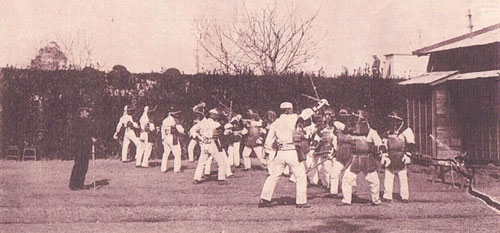
Most of the research and officer education on infantry warfare in the Imperial Japanese Army was conducted at the physical training department of Toyama Military Academy. From the onset the close quarter combat technique taught in the Academy was based on the French Military style where the saber was commonly held in one hand.
Cover:The Techniques and Tameshigiri of Gunto (military sword)
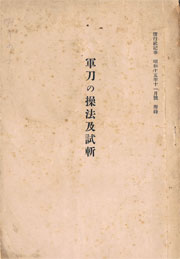
However through the Japan-China War(1894~1895) and Japan-Russia War (1904~1905), the reliability of Japanese sword, katana, was re-appraised and its spiritual side also started to attract the psyche of the time. By winning these wars, the Imperial Japanese Army was now developing up to the level of world powers and during this period the holding style of the saber was changed from one hand to two hands. With this background, during the Taisho period, Toyama Military Academy started to investigate more traditional Japanese swordsmanship in order to develop a uniquely Japanese military style sword fighting to be introduced, inviting traditional katana sword masters such as Nakayama Hakudo and Kunii Zenya.
In 1925, Lieutenant Colonel Morinaga Kiyoshi, who was the head of the sword fighting in the Toyama Military Academy, officially adopted five Kata (forms) of tachi-waza, the sequences of movements starting from standing position, devised from Iai and formulated to modern warfare by Nakayama Hakudo. However, these were only practiced in the academy and were not disseminated to the whole army. In 1934, the Imperial Japanese Army officially switched its fighting sword from the western style saber to the traditional Japanese one with the 94 model military sword becoming the first Japanese katana style military sword, Gunto.
In 1940 the Toyama Military Academy, after revising and adding more Kata with the cooperation of Mochida Seiji, and Saimura Goro, commissioned Kendo masters in the academy, officially adopted seven tachi-wazas. These were included in a supplement of a leaflet ‘Kaiko-sha article, November 1940 issue’, called ‘The Techniques and Tameshigiri of Gunto (military sword)’ published in November 1940 by Kaiko-sha, a social organization of army officers. The leaflets were distributed to all the army officers thus making the Gunto Soho, developed at the Toyama Military Academy, known to the whole Imperial Japanese Army. In January 1942 ‘Gunto Intensive Training Manual – Kill with One Blow –’ was published and in March 1944, ‘Gunto Intensive Training Manual – Kill with One Blow –’ was revised as ‘Gunto Soho no.1’ and the original ‘Gunto Soho’ as ‘Gunto Soho no.2’, and the Toyama Military Academy combined both with some editing and published it as ‘Gunto Soho and Tameshigiri’ from Kokubo Budo Association.
September 2011
GUNTO SOHO, Toyamaryu Kata, Toyamaryu Kumitachi Kata documents are available in pdf format. Updated on September, 2014 (Password required).

- Gunto Soho
- 軍刀操法
- GUNTO SOHO (Military Sword Maneuver) had been established at Toyama Military Academy during the period of 1925~1944. This document was recreated as closely as possible to Original GUTO SOHO. It continuing the tradition of GUNTO SOHO under the guidance of ZNTIR. *Note: On July,2014,added the legends on several Fig (pictures) which are shown on original book of"Gunto Soho and Tameshigiri"for further clarification.

- Kata of Toyamaryu
- 戸山流形
- The Toyamaryu Kata originated with 7 Gunto Soho Kata which had developed at Toyama Military Academy of Imperial Japanese Army. After WW II, Zen-Nihon Toyamaryu Iaido Renmei had modified the first step from GUNTO SOHO's left to the right of classic Iai, added the Chiburi movement and Itomagoi Kata as 8th Kata.

- Kata of Toyamaryu Kumitachi
- 組太刀
- The pdf shows a detail of Toyamaryu Kumitachi which ZNTIR practices under the guidance of ZNTIR Education Unit.

- Judgung Points for Kata
- 形審査の留意点
- Kata basic points to pay attention for the everyday Keiko (from the seminar on August 24th 2014)


